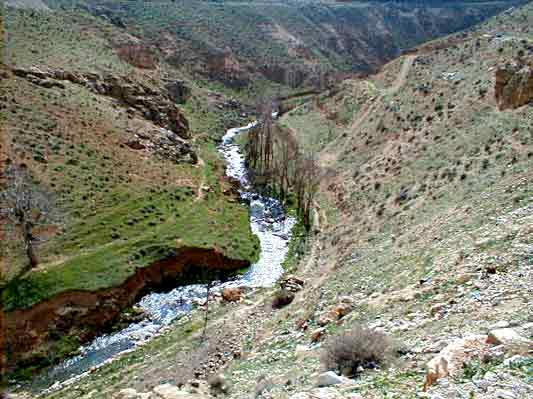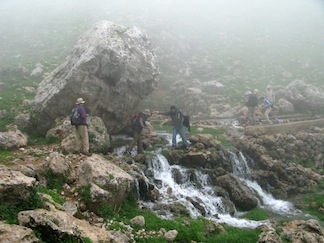- What is primary water and how is it different from other water sources? Primary Water (PW) is Earth-generated water. When conditions are right oxygen combines with hydrogen to make new water. This water is being pushed up under great pressure from deep within the Earth. It finds its way towards the surface of the Earth where there are fissures or faults. Depending on the geology, PW can be close to the surface, or even flow out as a spring. PW is new water that has never been a part of the hydrologic cycle until it finally arrives at the surface.
- How can we access primary water if it is so deep? The origins of PW are deep, but because it is under great pressure it moves upwards where possible. If PW confronts a blocking geologic structure it will remain deep. If PW moves up into weak areas of the Earth’s crust, it continues moving upward until it is blocked or finds its way to the surface. These weaker areas are often associated with mountain ranges where faults are common.
- Is there a way to prove that primary water really is separate from water cycle water? The proof for PW is to have the water tested for tritium (a radioactive isotope of hydrogen used as a fuel in thermonuclear bombs). If tritium is detected then it is not PW. If there is no tritium, then the water has never been involved in the hydrologic cycle (our solar generated water cycle).
- What are some well-known locations of primary water? Undoubtedly PW flows out or is being pumped out all over the world. PW even flows out of vents below sea level. These fresh water vents are well known around the world. There are PW wells associated with the Rift Valley of Africa that are being established in Kenya and Tanzania, the eastern source of the Jordan River, in California, Oregon, and other states of Western U.S. There are hundreds of examples of PW sources, but one is the Ain El Figeh Spring, a remarkable source of water, supplies over a million people of Damascus, Syria, and is also the principal source of the Barada River. A report on the spring states: “ …….. has been enclosed in a structure since the Roman times, resembles an underground river several meters across which flows up and out of the limestone formation of the mountain. The total flow has averaged 8.63 cubic meters per second (about 132,000 gpm).” It is important to consider that many mines in the world have been washed out before they could be worked out, and many working mines are pumping out thousands of gallons per day. Two examples are the Comstock mine in Nevada, and the Tombstone mine in Arizona. Eventually both had to be abandoned. At 3,200 feet down the Comstock mine encountered a washout. Several hydraulic pumps were employed finally lifting 5,200,000 gallons every 24 hours, or 3,600 gallons a minute. Within 36 hours after the pumps were stopped the water had risen, filling the entire lower workings of the mine.
- What makes PWI so qualified to source primary water? Pal Pauer, our chief hydrologist studied and worked for over 40 years with the pioneer of the art and science of PW, the geophysicist, Stephan Riess. Mr. Pauer has successfully located many hundreds of PW wells in various parts of the world.
- How does Pal find primary water and how is this different from how other people find water sources? Mr. Pauer uses a combination of methods to locate PW. He begins by analyzing a variety of maps (more variety the better) starting with an expanded view, then becoming more and more specific. This is followed by a physical site analysis and the identification of the exact location of the well site (if one exists). Hydrologists usually locate water sources within the context of the hydrologic cycle, while we locate water knowing that PW exists under pressure from below in relation to hard rock structures.
- What are the benefits of using primary water sources versus using traditional water sources? Primary Water is constantly being manufactured within the Earth so is a virtual endless source of water. Its use does not normally affect ground water levels. Hydrologic water, on the other hand, is finite and fluctuates in relation to available rain and/or snowmelt. PW is also of high quality, unless it comes in contact with contaminants as it rises toward the surface.
- If El Nino weather conditions are expected later this year, why should we care about primary water sources? Won’t the drought be relieved? Any society needs a dependable, long-term supply of good quality water. Predicted El Nino weather conditions do not always materialize. PW is abundant and is not affected by periods of drought.
- Why do so few people, including geologists and hydrologists, know about primary water? PW is understood by very few. It is only relatively recent that the mainstream scientific community has started to discover and publish articles regarding some aspect of PW. It is only a matter of time before PW will be understood and accepted as an important aspect of geo-hydrology.
- Can primary water be found in flat areas? Yes, there are still fault lines that cross “flat” areas. However, it is often more difficult to locate such structures.
- Is there any potential harm to the environment if we drill for primary water (e.g. fracking)? No, and because PW is continually being generated, subsidence (the gradual caving or sinking of an area of land), is not an issue. Thus pumping out PW does not create a void.
- Where did the term ‘Primary Water’ come from? The term “Primary Water” was coined by Stephan Riess, the geophysicist who independently discovered the existence of PW, pioneered its development, beginning in the 1930s until his death in late 1985.
- How much Primary Water is available? There is an endless supply of PW as long as there are the elements that constitute water: hydrogen and oxygen.
- How does Primary Water and water of the hydrologic cycle stay separate? PW and hydrologic water do not always remain separate. As is the nature of geology, there is every possible combination of geologic structures which under certain conditions can allow for the comingling of PW and hydrologic water.
- What is the proof that Primary Water exists? Isn’t it all part of the hydrologic cycle? If it is necessary to know if the water is Primary or not, the water can be tested for tritium. From the time when atomic testing began in the Pacific, hydrologic water has had traces of tritium in it. PW does not contain any tritium.
- Will I be taking away from my neighbor’s water if I drill for primary water? No, the pumping of PW does not affect local aquifers unless the same structure providing the PW is also recharging the local ground water.
'



